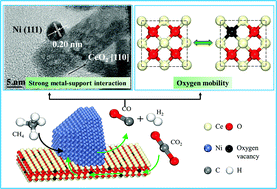Crystal-plane effect of nanoscale CeO2 on the catalytic performance of Ni/CeO2 catalysts for methane dry reforming†
Abstract
The morphology and crystal-plane effects of CeO2 materials (nanorods, nanocubes, nanooctas and nanoparticles) on the catalytic performance of Ni/CeO2 in methane dry reforming were investigated. The XRD and Raman results showed that Ni species can be incorporated into the lattices and induce the increase of oxygen vacancies by occupying the vacant sites in the CeO2 nanomaterials. The reaction experiments showed that the catalysts supported over CeO2 nanorods achieved significantly higher catalytic activity and better stability than the other three catalysts. This improved activity was closely related to the strong metal–support interaction between Ni and CeO2 nanorods, which showed great superiority in anchoring Ni nanoparticles. The oxygen vacancies and the mobility of lattice oxygen also showed morphology dependence. They can participate in the catalytic reaction and be favorable for the elimination of carbon deposition. Resistance to carbon deposition was found over the Ni/CeO2-nanorod catalyst, whereas large quantities of graphitic carbon species were formed over the Ni/CeO2-nanocube catalysts, which was responsible for deactivation.


 Please wait while we load your content...
Please wait while we load your content...